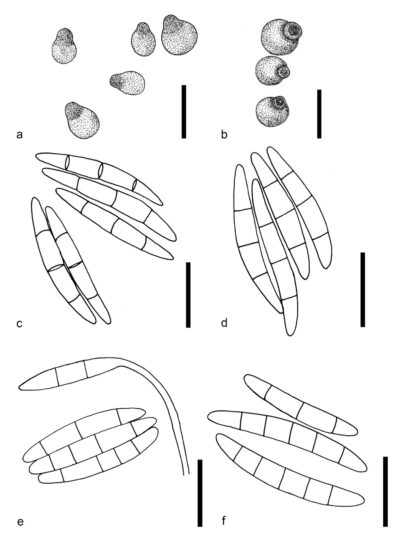Fungalpedia – Note 327, Tumenectria
Tumenectria Salgado & Rossma
Citation when using this entry: Perera et al. 2024 (in prep) – Fungalpedia, genera described in 2016.
Index Fungorum, Facesoffungi, MycoBank, GenBank, Fig. 1
Classification: Nectriaceae, Hypocreales, Hypocreomycetidae, Sordariomycetes, Pezizomycotina, Ascomycota, Fungi
Salgado-Salazar et al. (2016) introduced Tumenectria to accommodate Nectria laetidisca, which exhibits little resemblance to Nectria. Furthermore, N. laetidisca formed a monophyletic sister group to Campylocarpon and Rugonectria in an analysis of the concatenated act, ITS, LSU, rpb1, rpb2, SSU, tef, and tub2 loci (Salgado-Salazar et al. 2016). The genus is characterized by astromatic ascomata that arise alone or in multiples from a single point, and are easily detached from the substratum. They are 370–580 × 300–415 μm in size, globose, and have smooth perithecial walls. The orange-to-scarlet ascomata turned red in 3% KOH and yellow in the presence of lactic acid. Asci are narrowly clavate, and ascospores are fusiform, 3-septate, and hyaline. Tumenectria produces cylindrocarpon-like asexual morphs with 3–6-septate macroconidia (Salgado-Salazar et al. 2016). Tumenectria laetidisca is primarily associated with the woody substrates of bamboos (Salgado-Salazar et al. 2016).
Type species: Tumenectria laetidisca (Rossman) Salgado & Rossman
Other accepted species: Tumenectria is monotypic.
Figure 1 – Tumenectria laetidisca (a, c, d: CUP-MJ 768, b: CUP-MJ 770, e, f CBS 100284). a, b. Perithecia. c, d Ascospores. e, f Conidiophores and macroconidia on SNA. Scale bars: a, b = 500 μm, c–f = 50 μm. Redrawn from Salgado-Salazar et al. (2016)
Reference
Entry by
Rekhani Hansika Perera, Center of Excellence in Fungal Research, Mae Fah Luang University, Chiang Rai, 57100, Thailand.
(Edited by Kevin D. Hyde, Samaneh Chaharmiri-Dokhaharani, & Achala R. Rathnayaka)
Published online 27 August 2024
